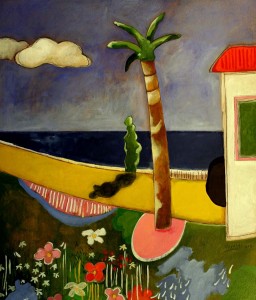Light, Colour and Symbols in Michalis Paintings

Acrylic on Marine Plywood,
105×90 cm,
Collection of the Artist
Michalis paintings are like a living, fresh memory on our eyelids from a deep dream we have just had. You feel as if everything ”has already been seen” a kind of deja vue as if they all derive from a hidden spiritual vessel where all archetypes of the pictures are held before being called to life’s surface to become experience.
The figurative view that meets the eye of the spectator is conceived through an opening, a window, or a balcony door often next to a decorated curtain. The light is that of the evening, as if moonlight, and spreads over the buildings like a reflection of something powerful while the shadows at the sides give a sense of mystery and riddle.
Palm-trees complete the composition in most of the pieces painted as an ideogram, as a given visual word. The roofs of the houses are many a time round often with a cross on them. The viewer need little time to realise that the painter is depicting evening landscapes in a Mediterranean country, landscapes that are peaceful, almost idealized, as if emanating from a dream which condenses and then offers up the atmosphere of a starry, late night.
The senses are moved, the dynamic scale of the illuminating breadth transmit atmospheric warmth. At the same time memories discreetly emerge. The shadows close to the buildings have the impenetrability of Dekiriko and forward of a certain surprise which may or may not occur. The arrangement of the buildings show a planned complex hive of life towards which our gaze moves full of affection nostalgia and a propensity toward shared participation. At certain moments the experienced art-lover recalls the old Modern-Greek Oriental School of Painting and great teachers such as S. Savvides or K. Maleas. At the same time, but with discretion images spring up from within, evocating of the cinematic romantic myth of the Mediterranean Sea such as ‘Casablanca’.
Michalis organises all these optical points and their prolongations through the use of simple proportions of synthesis, his final aim being, principally to promote painting and he succeeds in this by giving dominant roles not to the theme but to colour and light. Each colour hides within it traces of one adjacent just as in M. Rothko’s abstract contiguity where light antithesis is sufficiently modest to maintain colour activity effective but not dominant.
In the end, every work of art meets our eye as a picture distilled and matured over time within the depths of the artist’s soul as in our own, just as in a dream which we all have once experienced and remember with pleasure like a fairy tale that we so miss.
Harris Kampourides
Art Critic – Semiologist
Member of Academia Europaea
Athens, March 2009